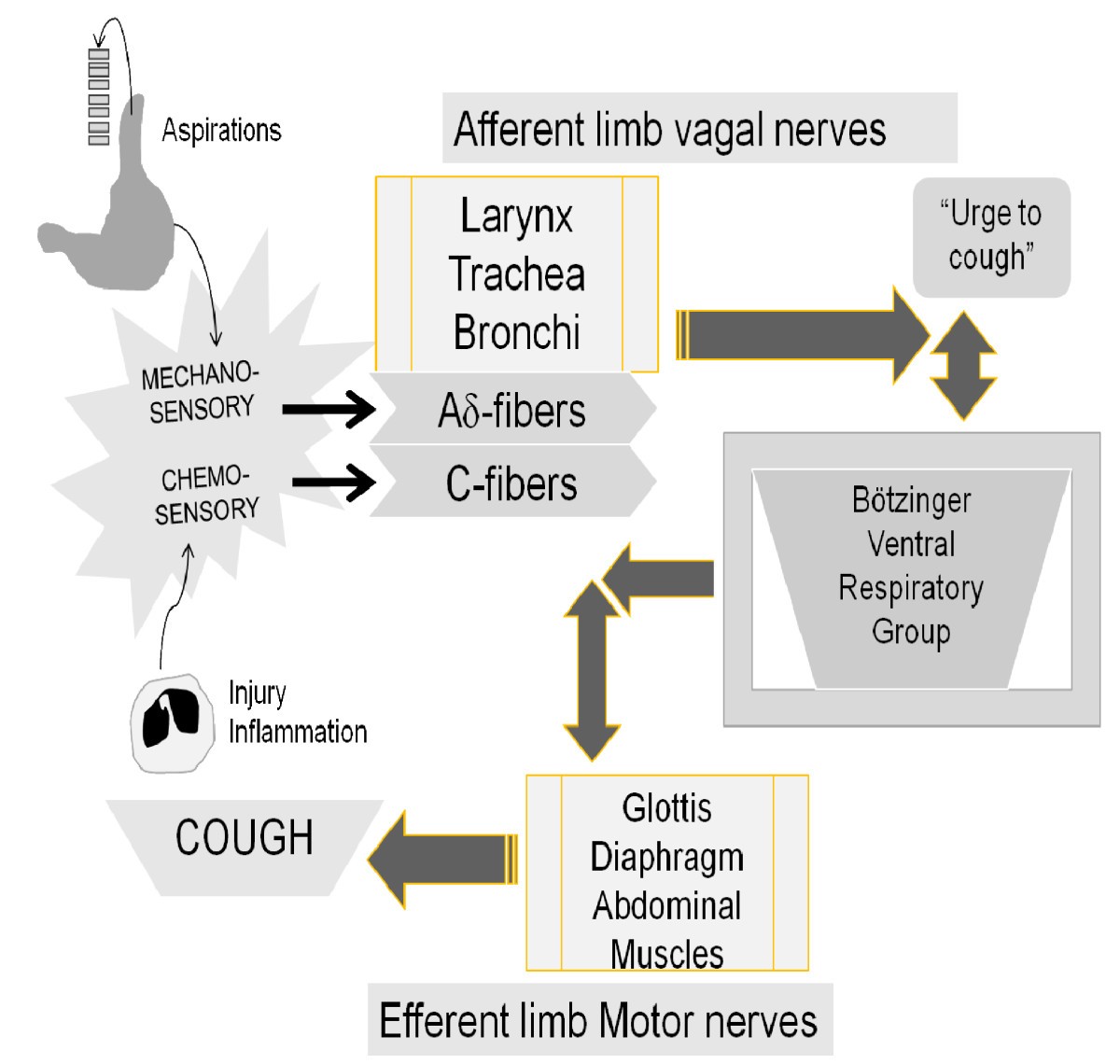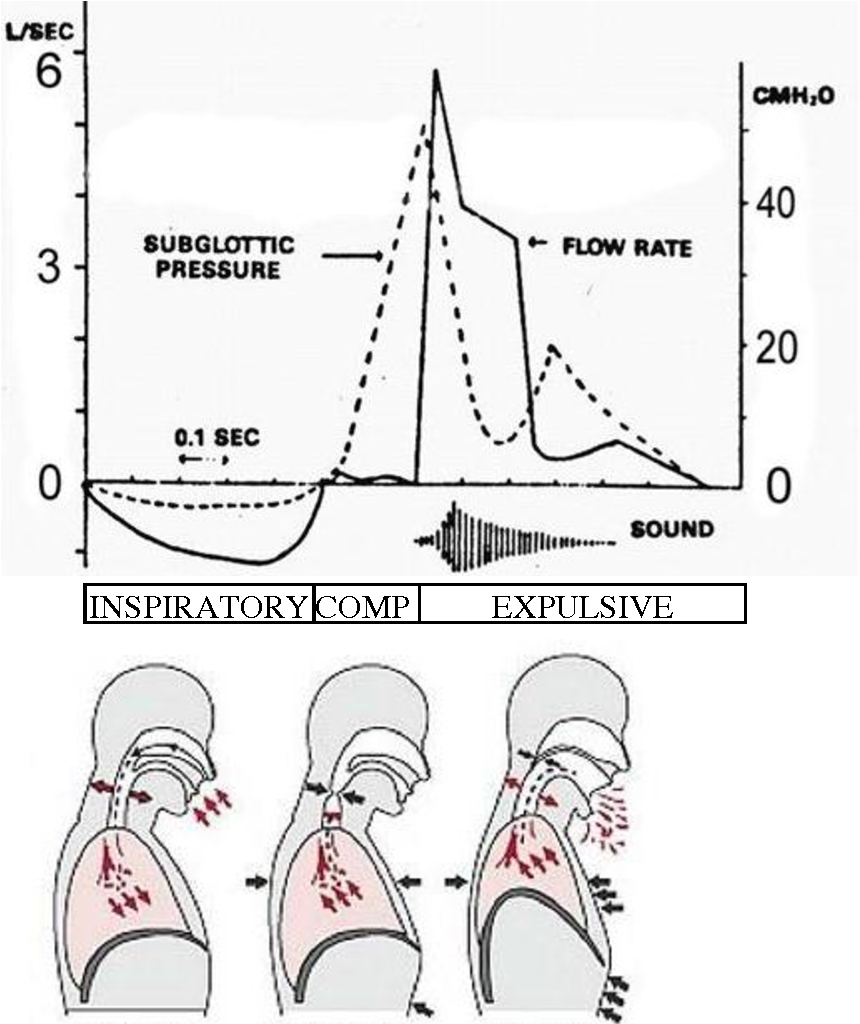Cough pathophysiology
|
Cough Microchapters |
|
Diagnosis |
|---|
|
Treatment |
|
Case Studies |
|
Cough pathophysiology On the Web |
|
American Roentgen Ray Society Images of Cough pathophysiology |
Editor-In-Chief: C. Michael Gibson, M.S., M.D. [1]; Associate Editor(s)-in-Chief: Cafer Zorkun, M.D., Ph.D. [2], M.Umer Tariq [3] Abiodun Akanmode,M.D.[4]
Pathophysiology
The act of coughing is a vital one that leads to the mucociliary clearance of excess secretions from the airway and other parts of the respiratory tree.Cough occurs via a complex neurophysiologic cough reflex arc.
Cough Reflex
The cough reflex is constituted by three main components ie
- The Afferent pathway: This is made up of sensory nerve fibers of the ciliated epithelium found in the upper airways. The afferent impulses are transmitted into the medulla.
- Central pathway: This is a central area located within the pons and brainstem. It coordinates the cough reflex arc.[1]
- The efferent pathway: cough impulses that are originated from the cough central travels via the vagus nerve,phrenic nerve, and spinal motor nerves to the diaphragm and abdominal wall muscles.
The Afferent sensory nerves
There are 3 major classes of afferent sensory nerves,this classification is based on there conduction velocity(A-fiber, > 3 m/s; C-fiber, < 2 m/s),origin ,myelination,neurochemistry etc.
- Rapidly adapting receptors (RARs)
- Slowly adapting stretch receptors (SARs)
- C-fibres.

Cough Mechanics
For an effective cough to be produced, a sequence of timed mechanical events divided into 3 phases has to take place.[2]
- The inspiratory phase: Here, there is inhalation of an appropriate amount of gas, the amount of gas inhaled tends to vary from 50% of the tidal volume to about 50% of the vital capacity.[3] [4]The inspiratory phase also bring about a structural change in the architecture of the expiratory muscles ie lenghtning and strentning of the expiratory muscles thus leading to the a generation of the required amount of intrathoracic pressure.
- The Compression Phase: The contraction of the muscles of the chest wall, abdominal wall, and the diaphragm against a closed glottis brings about a rapid increase in intrathoracic pressure.The pressure developed in the glotts during this compression phase could be as high as 300mmhg.[5]
- The Expiratory Phase: At this last phase, the glottis is open and the large intrathoracic pressure that was developed in the compressive phase brings about a large expiratory airflow and the unique sound associated with coughing.[5]

Dysfunction
The ability to cough efficiently and effectively cannot be overstated and when patients have impaired ability to cough, they are at an increased risk of atelectasis, pneumonia, and other chronic airways diseases secondary to aspiration and retention of secretions. In patients with chest wall deformities, abdominal wall deformities and other neuromuscular disorders may have problems generating the required flow pressure needed to clear respiratory secretions effectively.[6][7]
Arnold's nerve cough reflex
This is a very rare nerve disorder associated with chronic cough, in patients with this disorder, the stimulation of the external auditory meatus leads to the activation of the auricular branch of the vagus nerve(Arnold's nerve) thus stimulating the cough reflex. Treatment of patients with this condition and other sensory vagal neuropathy with chronic coughis with gabapentin.[8]
During Injections
Coughing during an injection can lessen the pain of the needle stick caused by a sudden, temporary rise in pressure in the chest and spinal canal, inhibiting the pain-conducting structures of the spinal cord.[9]
References
- ↑ Polverino M, Polverino F, Fasolino M, Andò F, Alfieri A, De Blasio F (2012). "Anatomy and neuro-pathophysiology of the cough reflex arc". Multidiscip Respir Med. 7 (1): 5. doi:10.1186/2049-6958-7-5. PMC 3415124. PMID 22958367.
- ↑ BUCHER K (1958). "Pathophysiology and pharmacology of cough". Pharmacol Rev. 10 (1): 43–58. PMID 13542168 PMID: 13542168 Check
|pmid=value (help). - ↑ Harris RS, Lawson TV (1968). "The relative mechanical effectiveness and efficiency of successive voluntary coughs in healthy young adults". Clin Sci. 34 (3): 569–77. PMID 5666883 PMID: 5666883 Check
|pmid=value (help). - ↑ Yanagihara N, Von Leden H, Werner-Kukuk E (1966). "The physical parameters of cough: the larynx in a normal single cough". Acta Otolaryngol. 61 (6): 495–510. doi:10.3109/00016486609127088. PMID 5963004.
- ↑ 5.0 5.1 McCool FD (2006). "Global physiology and pathophysiology of cough: ACCP evidence-based clinical practice guidelines". Chest. 129 (1 Suppl): 48S–53S. doi:10.1378/chest.129.1_suppl.48S. PMID 16428691 PMID: 16428691 Check
|pmid=value (help). - ↑ Polverino M, Polverino F, Fasolino M, Andò F, Alfieri A, De Blasio F (2012). "Anatomy and neuro-pathophysiology of the cough reflex arc". Multidiscip Respir Med. 7 (1): 5. doi:10.1186/2049-6958-7-5. PMC 3415124. PMID 22958367 PMID: 22958367 Check
|pmid=value (help). - ↑ Schramm CM (2000). "Current concepts of respiratory complications of neuromuscular disease in children". Curr Opin Pediatr. 12 (3): 203–7. doi:10.1097/00008480-200006000-00004. PMID 10836153 PMID: 10836153 Check
|pmid=value (help). - ↑ Ryan NM, Gibson PG, Birring SS (2014). "Arnold's nerve cough reflex: evidence for chronic cough as a sensory vagal neuropathy". J Thorac Dis. 6 (Suppl 7): S748–52. doi:10.3978/j.issn.2072-1439.2014.04.22. PMC 4222929. PMID 25383210 PMID: 25383210 Check
|pmid=value (help). - ↑ Usichenko, TI (2004). "Reducing venipuncture pain by a cough trick: a randomized crossover volunteer study". Anesthesia and Analgesia. 99 (3): 952–3. PMID 14742367. Unknown parameter
|coauthors=ignored (help);|access-date=requires|url=(help)